A long time ago seaborn There are some involved but not explored in depth , This time there is a need for data visualization , Just learn
Seaborn In fact matplotlib On the basis of a more advanced API encapsulation , So it's easier to draw , Use... In most cases seaborn Can make a very attractive picture , It provides great convenience for data analysis . But you should Seaborn As matplotlib A supplement to , It's not a substitute .
This time start with the most basic icon style and palette , Study seaborn.
# utilize matplotlib Create a sine function and graph
def sinplot(flip=1):
x = np.linspace(0, 14, 100)
# fig = plt.figure(figsize=(10,6))
for i in range(1,7):
plt.plot(x, np.sin(x + i * .5) * (7 - i) * flip)
sinplot()
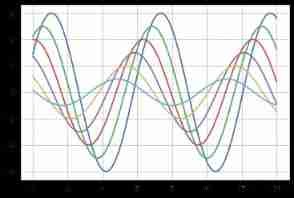
seaborn.set(context =‘notebook’,style =‘darkgrid’,palette =‘deep’,font =‘sans-serif’,font_scale = 1,color_codes = True,rc = None)
sns.set(style='darkgrid',font_scale=1.5)
# With this method, you can quickly set seaborn The default style of , Of course, you can also add parameters to set other styles
# font_scale:float, A separate scaling factor can scale the size of a font element independently .
sinplot()
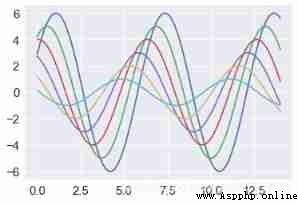
seaborn.set_style(style = None,rc = None )
# Switch seaborn Chart style
# Style choices include :"white", "dark", "whitegrid", "darkgrid", "ticks"
# rc:dict, Optional , Parameter mapping to override the preset seaborn Values in the style Dictionary
fig = plt.figure(figsize=(10, 8))
ax1 = fig.add_subplot(2, 1, 1)
sns.set_style('whitegrid',{
"xtick.major.size": 10, "ytick.major.size": 10})
data = np.random.normal(size=(20,6)) + np.arange(6) / 2
sns.boxplot(data=data)
ax2 = fig.add_subplot(2, 1, 2)
sinplot()
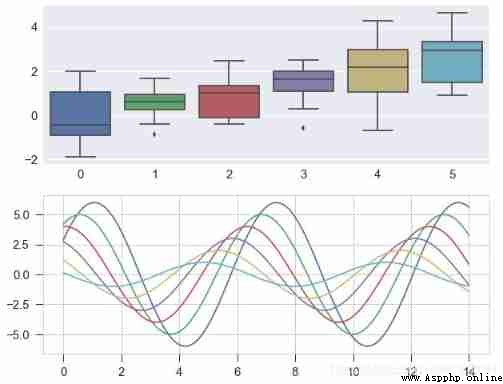
seaborn.despine(fig=None, ax=None, top=True, right=True, left=False, bottom=False, offset=None, trim=False)
# Set chart axis
sns.set(style='ticks',font_scale=1)
# Set style
fig = plt.figure(figsize=(10,12))
plt.subplots_adjust(hspace=0.3) # Adjust the spacing of subgraphs
# Chart basic settings
ax1 = fig.add_subplot(3, 1, 1)
sinplot()
sns.despine(ax=ax1)
# The right and upper axes are hidden by default
ax2 = fig.add_subplot(3, 1, 2)
sns.violinplot(data=data)
sns.despine(ax=ax2,offset={
'bottom':5,'left':10})
# offset : Whether the coordinate axes are offset separately , Positive values move outward , Negative values move inward . The dictionary can be used to set... For each axis individually
# trim: When it comes to True when , Both ends of the coordinate axis are limited to the maximum and minimum values of the data
ax3 = fig.add_subplot(3, 1, 3)
sns.boxplot(data=data, palette='deep')
sns.despine(ax=ax3,left=True, right= False, trim=True,
offset={
'bottom':10,'right':10})
# top, right, left, bottom: Boolean type , by True Time does not show
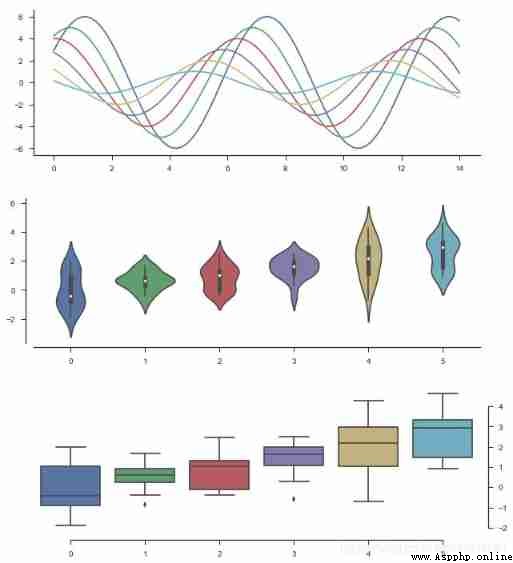
# 4、axes_style()
# Set local chart style , Can learn and with Use of coordination
fig = plt.figure(figsize=(10,8))
with sns.axes_style("darkgrid"):
plt.subplot(211)
sinplot()
# Set local chart style , use with Make code block distinction
sns.set_style("whitegrid")
plt.subplot(212)
sinplot()
# External table style
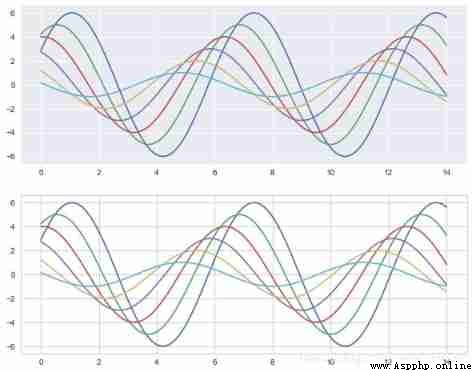
seaborn.set_context(context = None,font_scale = 1,rc = None )
# Set the display scale
# Options include :'paper', 'notebook', 'talk', 'poster'. These four are preset . Does not affect the overall style .
# The default is notebook
sns.set_context("notebook")
sinplot()
plt.grid(linestyle='--')
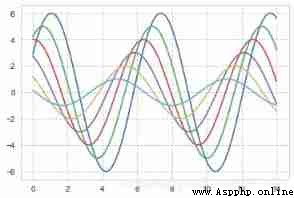
sns.color_palette(palette=None, n_colors=None, desat=None)
We often choose colors according to data characteristics , So let's start with
classification : They differ greatly from each other continuity : Color gradients in order Divergence : Light in the middle , Both ends are dark Three palettes to explain color_palette() function
When you don't have to distinguish the order of discrete data , It is recommended to use the classification palette
# Default 6 Color :deep, muted, pastel, bright, dark, colorblind
# n_colors:int, Number of colors in the palette
# dasat:float, Desaturation 0-1 Between
current_palette = sns.color_palette()
sns.palplot(current_palette)
# When called without parameters, all colors in the current default color loop will be returned
# You can pass in anything matplotlib Supported colors

When you need to 6 Medium or above , You can draw colors at uniform intervals in a circular color space .
The most common is the use of hls Color space .
sns.palplot(sns.color_palette('hls',8))
# The number of color patches is 8 individual

data = np.random.normal(size=(10, 8)) + np.arange(8) / 2
sns.boxplot(data=data,palette=sns.color_palette("hls", 8))
plt.show()
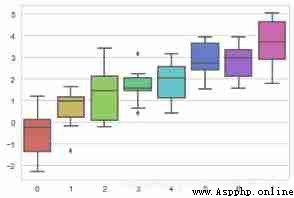
# Set brightness , saturation
# h - The first tone
# l - brightness
# s - saturation
sns.palplot(sns.husl_palette(8, l=.6, s=.7))
# This one looks more comfortable , It's easier to distinguish

Another category palette comes from Color Brewer( It also has a continuous palette and a divergent palette ), It also exists in matplotlib colormaps in , But it has not been well handled . stay Seaborn in , When you call Color Brewer When sorting color swatches , You can always get discrete colors , But that means they start a cycle at some point .
Color Brewer A good feature of the website is that it provides some guidance on which color palettes are color blind safe
# Color Brewer color setting
sns.palplot(sns.color_palette("Paired",8))
sns.palplot(sns.color_palette("Set1",10))


xkcd Contains a series of names RGB Color . common 954 Color , You can now use xkcd_rgb The dictionary is seaborn They are quoted in :
plt.plot([0, 1], [0, 1], sns.xkcd_rgb["pale red"], lw=3)
plt.plot([0, 1], [0, 2], sns.xkcd_rgb["medium green"], lw=3)
plt.plot([0, 1], [0, 3], sns.xkcd_rgb["denim blue"], lw=3)
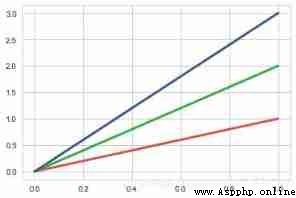
When data ranges from relatively low or uninteresting values to relatively high or interesting values , Continuous... Can be used ( The order ) palette , stay kdeplot() and heatmap() Functions are often used .
Color maps with large hue shift often introduce discontinuities that do not exist in the data , And our visual system cannot naturally map rainbows to things like “ high ” or “ low ” Quantitative differences . The result is that these visualizations are ultimately more like a puzzle , They blur patterns in the data rather than reveal them
So for sequential data , It's best to use a palette with the most subtle shifts in hues , Accompanied by large changes in brightness and saturation . This approach naturally draws attention to the relatively important parts of the data
sns.palplot(sns.color_palette("Blues"))
sns.palplot(sns.color_palette("Blues_r"))
# And matplotlib In the same , If you want to reverse the brightness gradient , Then it can be _r Add a suffix to the palette name
# Not all colors can be reversed !!!


cubehelix The palette system is a linear palette that can change both brightness and hue . This means that when converted to black and white ( For printing ) Or when viewed by a color blind individual , The information in the color map will be preserved .
seaborn.cubehelix_palette(n_colors = 6,start = 0,rot = 0.4,gamma = 1.0,hue = 0.8,light = 0.85,dark = 0.15,reverse = False,as_cmap = False )
# Calculated according to linear growth , Set the color
sns.palplot(sns.color_palette("cubehelix", 8))
sns.palplot(sns.cubehelix_palette(8, gamma=2))
sns.palplot(sns.cubehelix_palette(8, start=.5, rot=-.75))
sns.palplot(sns.cubehelix_palette(8, start=2, rot=0, dark=0, light=.95, reverse=True))
# n_colors → Number of colors
# start → The value range is [0,3], Start color
# rot → float, Color rotation angle , May be (-1,1) Between
# gamma → Color gamma value ,>1 Brighter ,<1 Darker
# dark,light → Value range 0-1, The color is dark and light
# reverse → Boolean value , The default is False, From shallow to deep




For a simple interface to customize the order palette , You can use light_palette() Or use dark_palette(), Is a single color and generates a gradient palette from light or dark desaturation values to that color . These functions are accompanied by the ability to launch interactive widgets to create these palettes
seaborn.light_palette(color,n_colors = 6,reverse = False,as_cmap = False,input =‘rgb’ )
seaborn.dark_palette(color,n_colors = 6,reverse = False,as_cmap = False,input =‘rgb’ )
# color: Hex code ,html Color name or input Tuples in space
# input: {'rgb','hls','husl',xkcd'}
# The color space used to interpret the input color . The first three options apply to tuple input , The latter applies to string input
sns.palplot(sns.light_palette("green"))# according to green Make a light palette
sns.palplot(sns.dark_palette('green', reverse=True))# according to green Make a dark palette
sns.palplot(sns.light_palette((260, 75, 60), input="husl"))
sns.palplot(sns.dark_palette("muted purple", input="xkcd"))




The third type of palette is called “ Divergence ”. These are interesting data for both high and low values . There is usually a well-defined midpoint in the data . for example , If you want to plot the temperature change at a baseline time point , It is better to use the deviation color chart to show the relatively reduced areas and the relatively increased areas .
It is also important to emphasize that the use of red and green should be avoided , Because a large number of potential viewers will not be able to distinguish them
seaborn.diverging_palette(h_neg, h_pos, s=75, l=50, sep=10, n=6,
center=‘light’, as_cmap=False)
# Create a scatter color
# h_neg, h_pos → start / End color value
# s → Value range 0-100, saturation
# l → Value range 0-100, brightness
# n → Number of colors
# center → Is the center color light or dark “light”,“dark”, The default is light
# Color Brewer The library comes with a carefully selected set of divergent color maps
sns.palplot(sns.color_palette("BrBG", 7))
# Of course, you can customize it yourself
sns.palplot(sns.diverging_palette(145, 280, s=85, l=25, n=7))


plt.figure(figsize = (8,6))
x = np.arange(16).reshape(4, 4)
cmap = sns.diverging_palette(200, 20, sep=16, as_cmap=True)
sns.heatmap(x, cmap=cmap)
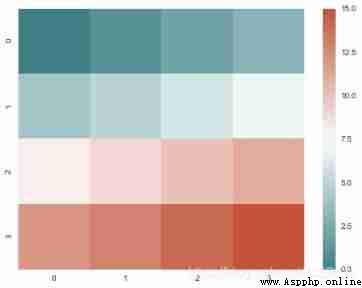
You can use the choose_colorbrewer_palette() Function to play various color options , If you want the return value to be passed to seaborn or matplotlib Functional colormap object , Then you can put as_cmap Parameter set to True
seaborn.choose_colorbrewer_palette(data_type, as_cmap=False)
sns.choose_colorbrewer_palette('q')
# sequential: The order , It can be used s Instead of
# diverging: Divergence , It can be used d Instead of
# qualitative: classification , It can be used q Instead of

# Color Brewer Color map of :
# Accent, Accent_r, Blues, Blues_r, BrBG, BrBG_r, BuGn, BuGn_r, BuPu,
# BuPu_r, CMRmap, CMRmap_r, Dark2, Dark2_r, GnBu, GnBu_r, Greens, Greens_r, Greys,
#Greys_r, OrRd, OrRd_r, Oranges, Oranges_r, PRGn, PRGn_r,
# Paired, Paired_r, Pastel1, Pastel1_r, Pastel2, Pastel2_r, PiYG, PiYG_r, PuBu, PuBuGn,
#PuBuGn_r, PuBu_r, PuOr, PuOr_r, PuRd, PuRd_r, Purples,
# Purples_r, RdBu, RdBu_r, RdGy, RdGy_r, RdPu, RdPu_r, RdYlBu, RdYlBu_r, RdYlGn, RdYlGn_r,
# Reds, Reds_r, Set1, Set1_r, Set2, Set2_r, Set3,
# Set3_r, Spectral, Spectral_r, Wistia, Wistia_r, YlGn, YlGnBu, YlGnBu_r, YlGn_r, YlOrBr,
# YlOrBr_r, YlOrRd, YlOrRd_r, afmhot, afmhot_r,
# autumn, autumn_r, binary, binary_r, bone, bone_r, brg, brg_r, bwr, bwr_r, cool, cool_r,
# coolwarm, coolwarm_r, copper, copper_r, cubehelix,
# cubehelix_r, flag, flag_r, gist_earth, gist_earth_r, gist_gray, gist_gray_r, gist_heat,
# gist_heat_r, gist_ncar, gist_ncar_r, gist_rainbow,
# gist_rainbow_r, gist_stern, gist_stern_r, gist_yarg, gist_yarg_r, gnuplot, gnuplot2,
# gnuplot2_r, gnuplot_r, gray, gray_r, hot, hot_r, hsv,
# hsv_r, icefire, icefire_r, inferno, inferno_r, jet, jet_r, magma, magma_r, mako,
# mako_r, nipy_spectral, nipy_spectral_r, ocean, ocean_r,
# pink, pink_r, plasma, plasma_r, prism, prism_r, rainbow, rainbow_r, rocket, rocket_r,
# seismic, seismic_r, spectral, spectral_r, spring,
# spring_r, summer, summer_r, terrain, terrain_r, viridis, viridis_r, vlag, vlag_r, winter, winter_r
Be similar to color_palette().set_palette() Accept the same parameters , But it will change the default matplotlib Parameters , So that the palette Apply to all drawings .
# After setting the palette , Chartcreate charts
sns.set_style("whitegrid")
fig = plt.figure(figsize=(8,6))
# Set style
with sns.color_palette("PuBuGn_d"):
plt.subplot(211)
sinplot()
sns.set_palette("husl")
plt.subplot(212)
sinplot()
# Draw series colors

 Python will tell you in two minutes how to brutally crack the WiFi password of Lao Wang next door
Python will tell you in two minutes how to brutally crack the WiFi password of Lao Wang next door
Preface : It is said that “ Ho
 Python crawler engineers here, do you dare to crawl the site of a law firm?
Python crawler engineers here, do you dare to crawl the site of a law firm?
Table of Contents ️ 實戰場景&